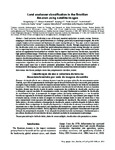Por favor, use este identificador para citar o enlazar este ítem:
http://www.alice.cnptia.embrapa.br/alice/handle/doc/940299Registro completo de metadatos
| Campo DC | Valor | Lengua/Idioma |
|---|---|---|
| dc.contributor.author | LU, D. | pt_BR |
| dc.contributor.author | BATISTELLA, M. | pt_BR |
| dc.contributor.author | LI, G. | pt_BR |
| dc.contributor.author | MORAN, E. | pt_BR |
| dc.contributor.author | HETRICK, S. | pt_BR |
| dc.contributor.author | FREITAS, C. DA C. | pt_BR |
| dc.contributor.author | SANT'ANNA, S. J. | pt_BR |
| dc.date.accessioned | 2012-11-22T11:11:11Z | pt_BR |
| dc.date.available | 2012-11-22T11:11:11Z | pt_BR |
| dc.date.created | 2012-11-22 | pt_BR |
| dc.date.issued | 2012 | pt_BR |
| dc.identifier.citation | Pesquisa Agropecuária Brasileira, Brasilia, DF, v. 47, n. 9, p. 1185-1208, set. 2012. | pt_BR |
| dc.identifier.uri | http://www.alice.cnptia.embrapa.br/alice/handle/doc/940299 | pt_BR |
| dc.description | Land use/cover classification is one of the most important applications in remote sensing. However, mapping accurate land use/cover spatial distribution is a challenge, particularly in moist tropical regions, due to the complex biophysical environment and limitations of remote sensing data per se. This paper reviews experiments related to land use/cover classification in the Brazilian Amazon for a decade. Through comprehensive analysis of the classification results, it is concluded that spatial information inherent in remote sensing data plays an essential role in improving land use/cover classification. Incorporation of suitable textural images into multispectral bands and use of segmentation?based method are valuable ways to improve land use/cover classification, especially for high spatial resolution images. Data fusion of multi?resolution images within optical sensor data is vital for visual interpretation, but may not improve classification performance. In contrast, integration of optical and radar data did improve classification performance when the proper data fusion method was used. Of the classification algorithms available, the maximum likelihood classifier is still an important method for providing reasonably good accuracy, but nonparametric algorithms, such as classification tree analysis, has the potential to provide better results. However, they often require more time to achieve parametric optimization. Proper use of hierarchical?based methods is fundamental for developing accurate land use/cover classification, mainly from historical remotely sensed data. | pt_BR |
| dc.language.iso | eng | eng |
| dc.rights | openAccess | eng |
| dc.subject | Data fusion | pt_BR |
| dc.subject | Multiple sensor data | pt_BR |
| dc.subject | Nonparametric classifiers | pt_BR |
| dc.title | Land use/cover classification in the Brazilian Amazon using satellite images. | pt_BR |
| dc.type | Artigo de periódico | pt_BR |
| dc.date.updated | 2014-10-28T11:11:11Z | pt_BR |
| dc.subject.nalthesaurus | Texture | pt_BR |
| dc.format.extent2 | p. 1185-1208. | pt_BR |
| riaa.ainfo.id | 940299 | pt_BR |
| riaa.ainfo.lastupdate | 2014-10-28 | pt_BR |
| dc.identifier.doi | dx.doi.org/10.1590/S0100-204X2012000900004 | pt_BR |
| dc.contributor.institution | DENGSHENG LU, INDIANA UNIVERSITY; MATEUS BATISTELLA, CNPM; GUIYING LI, INDIANA UNIVERSITY; EMILIO MORAN, INDIANA UNIVERSITY; SCOTT HETRICK, INDIANA UNIVERSITY; CORINA DA COSTA FREITAS, INPE; SIDNEI JOÃO SIQUEIRA SANT'ANNA, INPE. | pt_BR |
| Aparece en las colecciones: | Artigo em periódico indexado (CNPM)  | |
Ficheros en este ítem:
| Fichero | Descripción | Tamaño | Formato | |
|---|---|---|---|---|
| BatistellaPAB.pdf | 7,75 MB | Adobe PDF |  Visualizar/Abrir |









